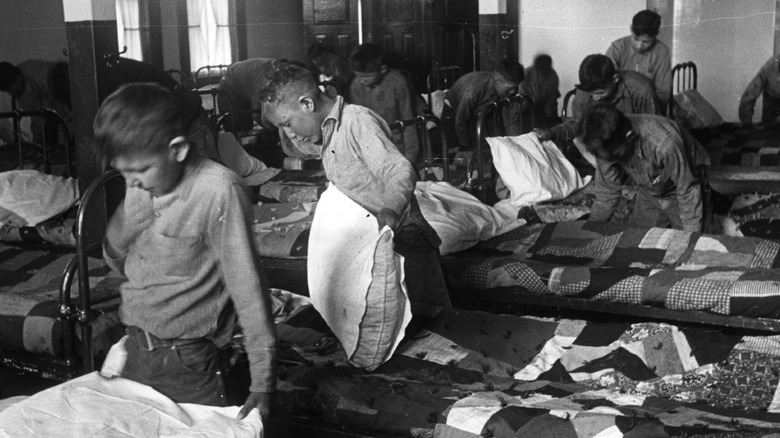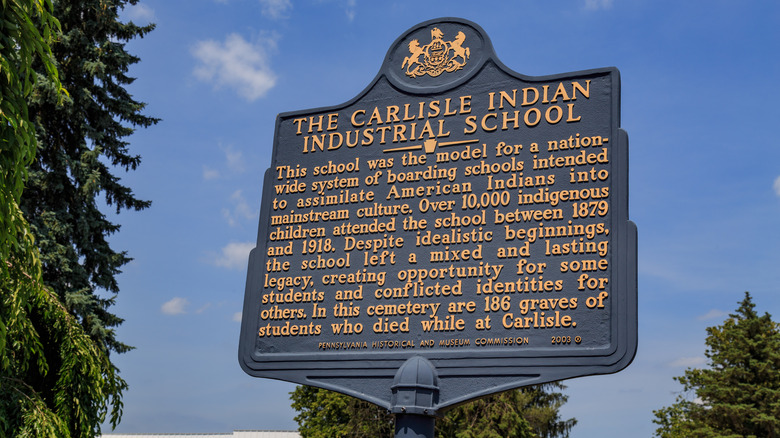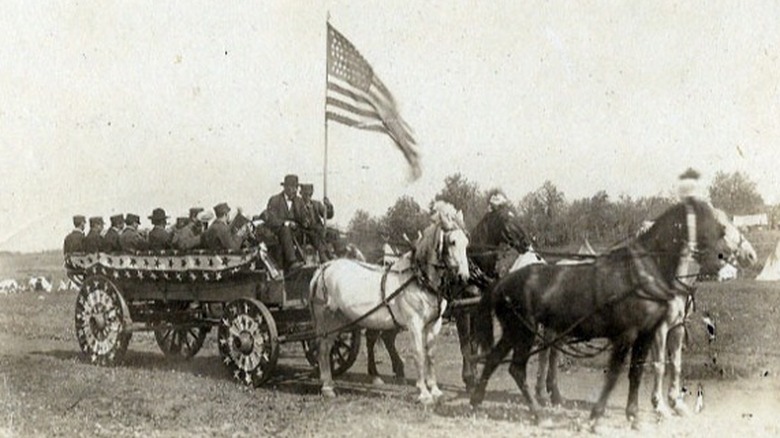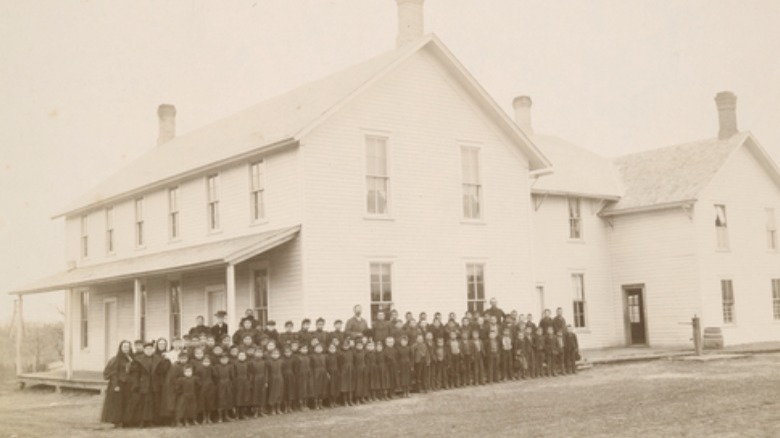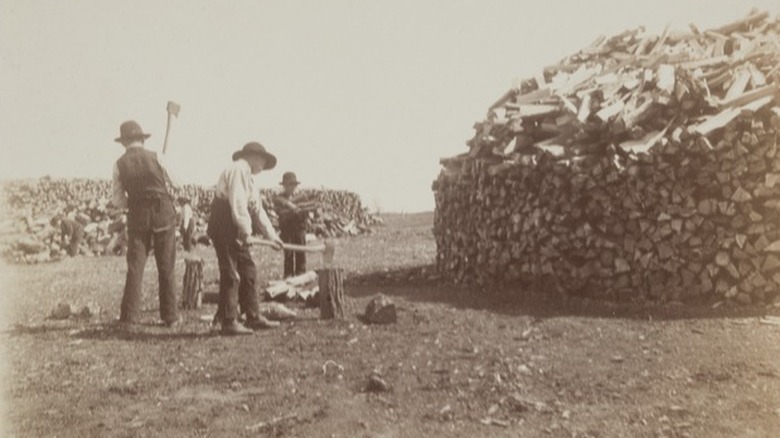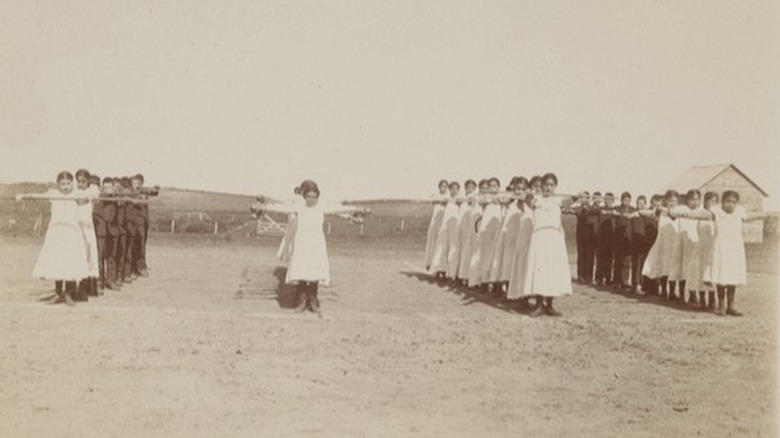The US Admits The Horrifying Truth About Indian Boarding Schools
The horrible treatment of Native Americans is well documented, and one aspect of the United States' policy toward indigenous groups involved placing Native children in boarding schools. Over 400 such schools operated across the United States from 1819 to 1969, according to the U.S. Department of the Interior. In these boarding schools, children were forced to abandon their heritage and culture.
In 2021, Secretary of the Interior Deb Haaland announced the Federal Indian Boarding School Initiative. This program is intended to review the United States government's former federal boarding school policies. "The Interior Department will address the inter-generational impact of Indian boarding schools to shed light on the unspoken traumas of the past, no matter how hard it will be," Haaland said.
The Federal Indian Boarding School Initiative Investigative Report was released in 2022. That report detailed the conditions that Native American children had to endure as the government tried to forcibly assimilate them into White American society.
How Native American boarding schools came to be
In 1819, the United States Congress passed a piece of legislation known as the Cvilization Fund Act. According to The Indigenous Foundation, the bill called for American education to be provided to indigenous people across the nation. This was the start of the U.S. policies geared toward the assimilation of Native Americans, or as it was sometimes known, the "civilization process."
Decades later, federally-funded boarding schools started popping up across the United States and its territories. The boarding schools were up and running by 1860 and were operated by a combination of federal employees and Christian missionaries. In 1879, the United States Bureau of Indian Affairs opened the first boarding school on a Native American reservation – the Yakima (now Yakama) Indian Reservation in Washington.
While it may seem like "providing education" would be a good thing, quotes from those who operated the schools show that it wasn't what was happening in these schools. Richard Henry Pratt ran the Carlisle Indian School in Carlisle, Pennsylvania. The school itself was modeled after an educational program Pratt had previously implemented at a prison in St. Augustine, Florida. In 1892, Pratt was quoted as saying, "A great general has said that the only good Indian is a dead one. In a sense, I agree with the sentiment, but only in this: that all the Indian there is in the race should be dead. Kill the Indian in him, and save the man."
Many of the boarding schools were on military installations
According to the Bureau of Indian Affairs report that was part of the Federal Indian Boarding School Initiative, many of the boarding schools that were founded during this time were set up at military sites. Some had been decommissioned but others were still active. Considering that this is where so many of them were located, it shouldn't come as a surprise that military-style techniques bled into the schools. The report referred to identity-alteration methodologies that were used on Native American, Native Alaskan, and Native Hawaiian children.
The government report released in 2022 explicitly states that the schools "were designed to separate a child from his reservation and family, strip him of his tribal lore and mores, force the complete abandonment of his native language, and prepare him for never again returning to his people," a far cry from the 1819 Civilization Fund Act's stated goal of bringing American education to indigenous peoples, per The Indigenous Foundation.
Overcrowding and abuse in Native American boarding schools
The report from the Bureau of Indian Affairs — a part of the Department of the Interior — mentions that the officials now acknowledge "frankly and unequivocally that the provisions for the care of the Indian children in boarding schools are grossly inadequate." It's mentioned that Federal Indian Boarding School Initiative investigators found many instances of abuse — physical, sexual, and emotional — at federal boarding schools.
There are specific examples of how children were forced into these schools, despite there clearly not being enough room for them to be comfortable. White Earth Boarding School in Minnesota mandated that two students be put in each bed, while Kansas' Kickapoo Boarding School required three students to share one bed. A school in Oklahoma, Rainy Mountain Boarding School, pushed as many beds into a room as they could to the point that there was nowhere to walk, then forced multiple children into each bed.
If you or someone you know may be the victim of child abuse, please contact the Childhelp National Child Abuse Hotline at 1-800-4-A-Child (1-800-422-4453) or contact their live chat services.
Conditions in Native American boarding schools
Many of the military sites that were converted into Native American boarding schools had already been around for quite some time. Because of this many were unequipped with even the most basic amenities. According to the Federal Indian Boarding School Initiative report, many of these previously abandoned government facilities had been built "long before the modern period of lighting, ventilation, and conveniences, and they are often of poor construction, necessitating continued and expensive repair bills."
Additionally, diseases and malnutrition were rampant at many of the boarding schools, and the vast majority of the time they were without the health care facilities needed to properly treat the children. It was also found that many of the boarding schools required the Native American children who attended them to partake in hard physical labor. The 2022 report contains a quote from a previous report on the boarding schools that dated back to 1928. Even then, the physical labor forced upon the children was thought to "constitute a violation of child labor laws in most states."
Punishments and burial sites in the Native American boarding school system
According to the Federal Indian Boarding School Initiative report, the schools in the Native American boarding school system ruthlessly enforced their strict roles and doled out corporal punishments for those who ran afoul of them. Punishments included students being whipped, slapped, or flogged, being placed in solitary confinement, or — especially rough, considering how widespread malnourishment was known to be — having food withheld.
Another disturbing revelation in the report is that investigators were able to identify a series of marked and unmarked burial sites. Burial sites were located at 53 of the system's boarding schools. Of those, 33 were marked, six unmarked, and 14 schools contained both. The report did not disclose the precise location of the burial sites due to the very real concern of the sites being disturbed by vandals or even grave robbers.
These schools were not limited to the United States. According to CNN, in 2021 a similar burial site was discovered at a boarding school for First Nations children in Canada. British Columbia's Kuper Island Residential School was grimly known as Canada's Alcatraz. There were 160 unmarked graves discovered at the site.
